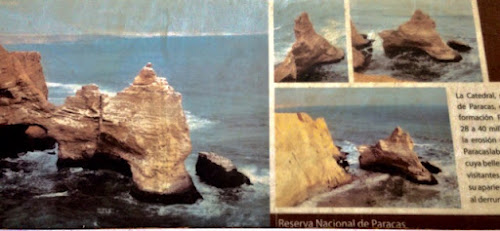Daily distances are short, elevation gains are large. A day spent climbing is not uncommon. Two consecutive days climbing is perfectly possible. Which means that there are some spectacular descents. Falling down through biospheres of ever changing climatic worlds. A freewheel from yet another of the 'claimed' world's highest cities; Cerro de Pasco starts in sleet and snow and ends with sugar cane. With a decent tailwind you needn't pedal for 110 km. Hell on brake pads, cramps on fingers, and as your not pedalling, not burning any energy, extremities get very cold. The good news is it won't last long; lapse rate says the temperature will rise six degrees for each thousand metres of drop; ....it does. Right down to a hot, unshaded plaza, from which were evicted by a zealous police woman. (she assumes that we're riding motorbikes). The 'bad news' is: that loss will need to be recouped tomorrow.
The up and down distances might be in proportion, it's the time that's out of kilter. Four-fifths of a day are spent muscling an at times uncooperative cycle up a mountain. Where the steepest gradients are always the inside corners of hair-pin bends, whose occurrence inevitability coincides with a long articulated lorry.
Yet it's the climbs that are the more interesting. We're passed by an open-backed truck that's clambering uphill in a reek of fumes. Chickens poke their heads out of a stack of crates, on top of which are boxes of eggs. The Andeñas are reposed in their colourful refinement on trussed sacks of soft traded goods, whilst the men and boys cling to the roof bars. As they pass they indicate that there's plenty of room for our bikes. I might beg to differ but, an Andean driver's ability to add cargo to an already overloaded vehicle is ably demonstrated every day.
We carry on plodding our way uphill. I can hear a pig somewhere up ahead. A distressed pig. An angry pig. We round the corner and find that same overloaded truck at a standstill. First impressions are of a breakdown, probably a puncture. Closer, and it becomes apparent that the angry pig is the cause, not that I can see it. It's inside a polyprop bag and is being energetically added to the cargo. Again we're offered a lift amongst all the hilarity.
We carry on the plod. Tiny villages cling to the verdant valley sides, the morning is moving very slowly forward. Around one corner we come on a chalked-up board offering cooked food. The power of advertising. Of course, we stop. There's never a great choice; on this occasion there was none. The classic: "Just feed me" almuerzo menu. To be honest I can't remember what it was, other than the fact that there would be a soup containing potatoes, pasta and a solitary hen's foot, that and a meat course heavy on rice and light on meat. What does remain from that dark, earth-floored shed was the 'chef' throwing an armful of harvested corn stalks into the kitchen's recesses and the squeaks of cuys erupting from all the corners of the establishment. There must have been upwards of fifty rodents converging on there meal. It's probably best not to be too particular in these situations, either to hygiene or the sensibilities of eating pet guinea pigs.
We plod on up hill. Passing through another village. Two ancient Andeñas in their stove-pipe hats are approaching; one has an unidentifiable bundle, the other a shawl of dry kindling. They greet me and I reciprocate. I carry on the slow grind, when I become aware that the Navigator isn't close behind. Stop and turn to find that she's been apprehended by those two ladies. It's I mime to me; she's doing a lot of gesticulated explaining with her hands. The interrogation completed they give her a hug. It's far from an isolated occurrence. There's a league of sisterhood emerging. I was to meet it further up that hill.
The plod continues. Another village. Almost certainly like all the previous ones. Then towards the end we see a sign that offers a hotel experience. A note to the unwary. There is no discernible differences In the terms hotel, hostel, hospedaje; titles are interchangeable. This one was a prime example.
And a new record that panders to the stereotypical Scot. It even breaks our Bolivian score. A room for S\10; ($3). Now for that l wouldn't expect much more than a lockable door and a clean set of sheets. And that's exactly what is on offer. A window would be a lux, a working plug useful. I didn't expect a shower and I wasn't disappointed. It's just another form of camping. This place turns out to be the local pueblo's, the co-operativo's establishment, and for me that's important. What little we spend stays in the village. It's being used by that great barometer for choice: the road repair squad. Ever need to decide which eatery to frequent, just look to see where the orange boiler-suits are and follow.
I return from my rudimentary cold water bucket wash, to discover that La Dueña has been around to offer the Navigator a shower. A hot water shower. The Sisterhood strikes again.

























